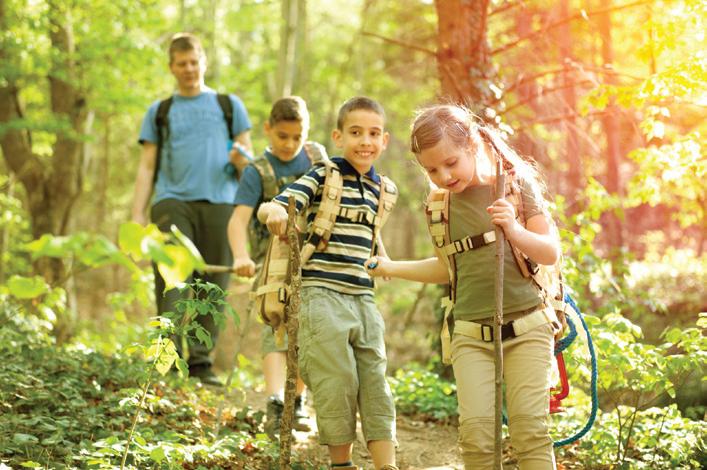
4 minute read
Big Trails Love Little Feet
download an audio recorder on your phone and carry it on your hike to record some of the sounds you hear. Search the Internet, encyclopedias, and books to discover the makers of calls you can’t decipher. Tree Tales Borrow some library books that describe the unique features of trees and their history. Use
Big Trails Love Little Feet Winter Family Hiking Tips
What better way to spend quality time with your family and get in touch with nature than a fresh, invigorating walk in the woods, along a river, or on a beach? What’s more, family hikes make for fun learning opportunities for kids and parents alike. So try some of these hiking activities with your youngsters. By Kimberly Blaker
Rock Hound Go on an excursion to learn about rocks and minerals. Learn which rocks and minerals are abundant in the area, and have each family member choose several to scout for. Take along a small plastic container with dividers, a descriptive rock and mineral guide, and a magnifying glass for viewing the colors, layers, and details. Aural Exploration Wander through a forest and listen carefully for a variety of bird and animal sounds. Before you go, visit your library for a DVD or audio CD of birds and wild animal calls. (The Cornell Lab of Ornithology’s website and app are great resources when it comes to identifying birds and birdsong. See birds.cornell.edu/home.) Then
clues such as the shape of the leaves, texture of bark, and size of the trunk to identify the kind of tree. Four-Legged and Feathered Friends Look for chipmunks and squirrels playing chase or gathering food; birds of prey circling overhead; or grazing rabbits and deer. Talk about what the animals eat, their shelters, and species they are related to. Also, keep eyes peeled for animal tracks to identify and determine how recently they were made. Creepy-Crawlies Carry an insect book, clear container, tweezers, and a magnifying glass for close examination of insects’ fascinating features. Bring a journal and track the types of insects you find. Beginner Botany Review some books on plants to spark your children’s interest. On each hiking trip, choose a different trail or area and see what plants grow in certain types of soil, climates, and in each season. As you inspect plants, look for their seeds, and notice the variations.
Talk about how seeds travel via the wind or the fur of animals. Carefully brush away the ground cover and look for seeds that have sprouted their roots. Learn how individual plants have evolved natural defenses that protect against creatures that would otherwise devour them. The Smart Daypack Carry a small daypack, extra clothing, and don’t forget hiking boots. Also bring along hats, sunglasses, sunblock, and insect repellant. When hiking off trails, use safety precautions to protect against tripping, getting lost, or other
Lake County
Clearlake Redbud Trail For older kids, try this 5.4-mile loop, which starts off in meadows and then heads up to views of forested hills before descending to Cache Creek. tuleyome.org/trails/redbud-trail Kelseyville Clear Lake State Park This park features three short trails that are just right for little legs. The .5-mile Kelsey Creek Trail is mostly level while the 2.2-mile Dorn Nature Trail loop offers more hills and views of Clear Lake. Meanwhile, the .4-mile Indian Nature Trail takes hikers through meadows. parks.ca.gov/?page_id=473
hazards, such as ticks and poison oak. Be prepared for emergencies: Carry a small flashlight and batteries, watch, map, bandages, and don’t forget plenty of water and snacks. Finally, to make the most of your nature quest carry binoculars, a magnifying glass, and a small camera.
Tykes on the Trail When hiking with children, keep these suggestions in mind: 1. Allow small legs plenty of time for breaks and know your child’s limitations. 2. Be familiar with potential dangers in the area; teach your children trail and animal safety. 3. Before you set out, let your kids know that there may be rules against taking their nature finds home. ¶
Kimberly Blaker is a freelance writer and founder and director of KB Creative Digital Services, an Internet marketing agency. See kbcreativedigital.com.
Mendocino County
Little River Van Damme State Park For a short trek through an out-of-theordinary landscape, check out the .25-mile Pygmy Forest Trail and
check out bonsai trees that grow in a bog-like environment. For an extended experience, continue on through the lushly vegetated Fern Canyon Trail, for a total hike of 4.5 miles. parks.ca.gov/?page_id=433 Ukiah Montgomery Woods State Natural Reserve The 1.8-mile forested Montgomery Grove Trail winds through redwoods, with a bridge granting passage over a creek. parks.ca.gov/?page_id=434
For more information about Lake County trails, go to konoctitrails. com/kids; for Mendocino County trails, see alltrails.com/us/ california/mendocino/kids.
Charles M. Schulz - Sonoma County Airport
Fly local & enjoy nonstop flights!
Seattle (SEA) Portland (PDX) Los Angeles (LAX) Orange County (SNA) San Diego (SAN) Phoenix (PHX) Dallas (DFW) San Francisco (SFO) Denver (DEN) Minneapolis (MSP) Las Vegas (LAS)
© P N T S
www.flySTS.com
NEED HELP GETTING LICENSED?


• Help with all aspects of opening a child care business in your home. • Free referrals to your program. • Ongoing support with technical assistance & free training workshops.






